NISSAN TEANA 2008 Service Manual
Manufacturer: NISSAN, Model Year: 2008, Model line: TEANA, Model: NISSAN TEANA 2008Pages: 5121, PDF Size: 69.03 MB
Page 3381 of 5121
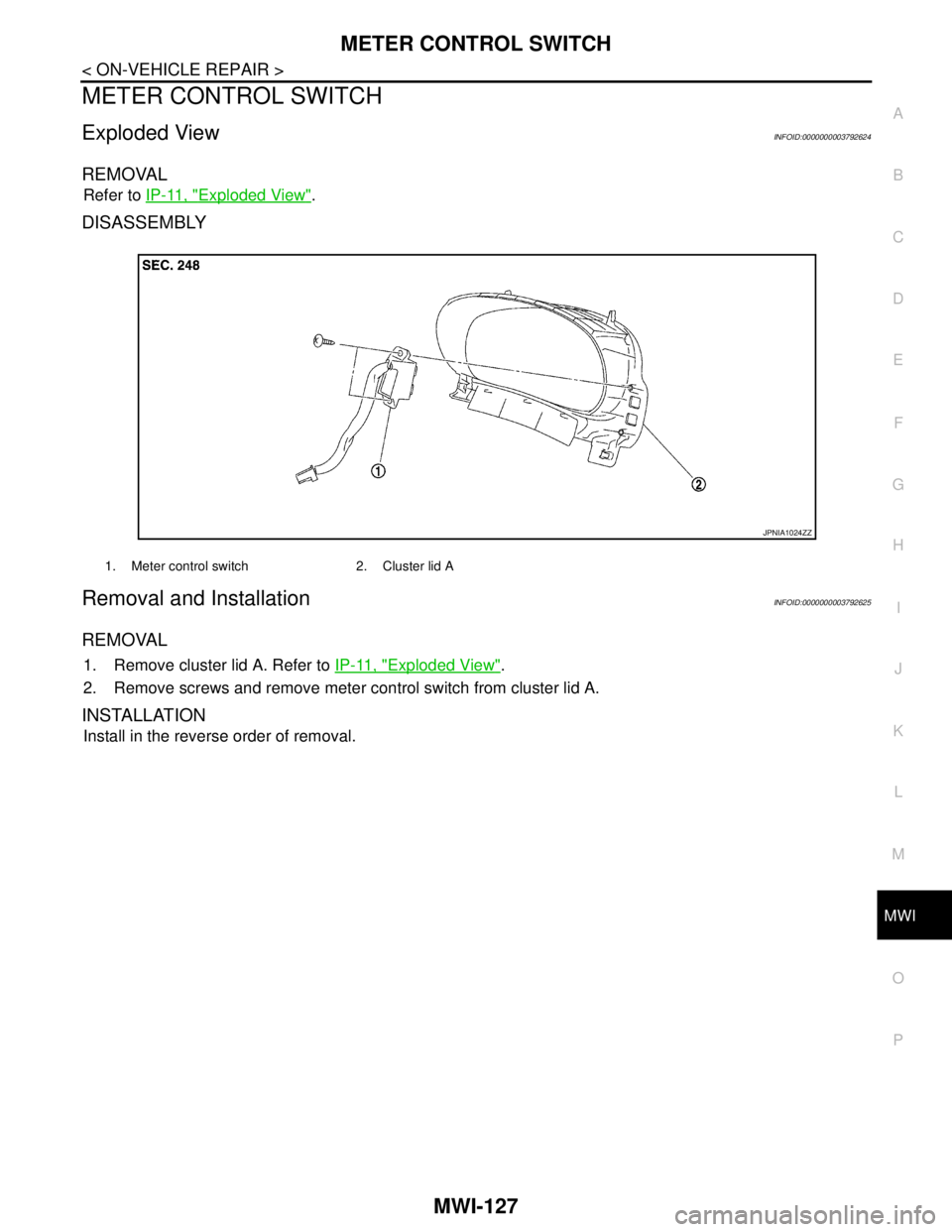
MWI
METER CONTROL SWITCH
MWI-127
< ON-VEHICLE REPAIR >
C
D
E
F
G
H
I
J
K
L
MB A
O
P
METER CONTROL SWITCH
Exploded ViewINFOID:0000000003792624
REMOVAL
Refer to IP-11, "Exploded View".
DISASSEMBLY
Removal and InstallationINFOID:0000000003792625
REMOVAL
1. Remove cluster lid A. Refer to IP-11, "Exploded View".
2. Remove screws and remove meter control switch from cluster lid A.
INSTALLATION
Install in the reverse order of removal.
1. Meter control switch 2. Cluster lid A
JPNIA1024ZZ
Page 3382 of 5121

PB-1
BRAKES
C
DE
G H
I
J
K L
M
SECTION PB
A
B
PB
N
O P
CONTENTS
PARKING BRAKE SYSTEM
ON-VEHICLE MAINTENA NCE .....................2
PARKING BRAKE SYSTEM .......................... .....2
Inspection and Adjustment .................................. ......2
PARKING BRAKE SHOE ...................................4
Adjustment .......................................................... ......4
ON-VEHICLE REPAIR ..................................5
PARKING BRAKE CONTROL ....................... .....5
Exploded View .................................................... ......5
Removal and Installation ...........................................5
Adjustment ................................................................6
PARKING BRAKE SHOE ..................................7
Exploded View ..................................................... .....7
Removal and Installation ..........................................7
Inspection and Adjustment .......................................8
SERVICE DATA AND SPECIFICATIONS
(SDS) ............... .............................................
10
SERVICE DATA AND SPECIFICATIONS
(SDS) .................................................................
10
Parking Drum Brake ............................................ ....10
Parking Brake Control .............................................10
Page 3383 of 5121
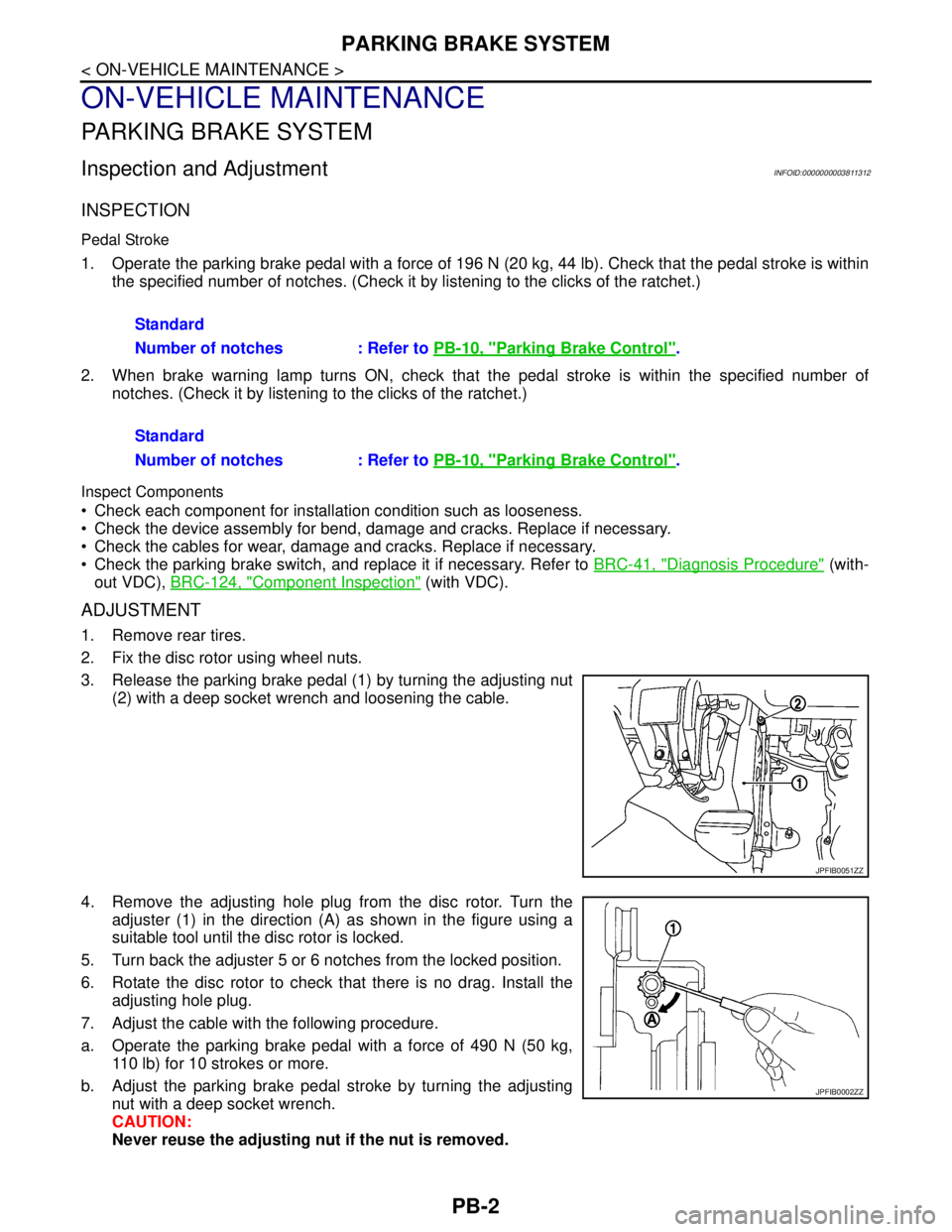
PB-2
< ON-VEHICLE MAINTENANCE >
PARKING BRAKE SYSTEM
ON-VEHICLE MAINTENANCE
PARKING BRAKE SYSTEM
Inspection and AdjustmentINFOID:0000000003811312
INSPECTION
Pedal Stroke
1. Operate the parking brake pedal with a force of 196 N (20 kg, 44 lb). Check that the pedal stroke is within
the specified number of notches. (Check it by listening to the clicks of the ratchet.)
2. When brake warning lamp turns ON, check that the pedal stroke is within the specified number of
notches. (Check it by listening to the clicks of the ratchet.)
Inspect Components
• Check each component for installation condition such as looseness.
Check the device assembly for bend, damage and cracks. Replace if necessary.
Check the cables for wear, damage and cracks. Replace if necessary.
Check the parking brake switch, and replace it if necessary. Refer to BRC-41, "
Diagnosis Procedure" (with-
out VDC), BRC-124, "
Component Inspection" (with VDC).
ADJUSTMENT
1. Remove rear tires.
2. Fix the disc rotor using wheel nuts.
3. Release the parking brake pedal (1) by turning the adjusting nut
(2) with a deep socket wrench and loosening the cable.
4. Remove the adjusting hole plug from the disc rotor. Turn the
adjuster (1) in the direction (A) as shown in the figure using a
suitable tool until the disc rotor is locked.
5. Turn back the adjuster 5 or 6 notches from the locked position.
6. Rotate the disc rotor to check that there is no drag. Install the
adjusting hole plug.
7. Adjust the cable with the following procedure.
a. Operate the parking brake pedal with a force of 490 N (50 kg,
110 lb) for 10 strokes or more.
b. Adjust the parking brake pedal stroke by turning the adjusting
nut with a deep socket wrench.
CAUTION:
Never reuse the adjusting nut if the nut is removed.Standard
Number of notches : Refer to PB-10, "
Parking Brake Control".
Standard
Number of notches : Refer to PB-10, "
Parking Brake Control".
JPFIB0051ZZ
JPFIB0002ZZ
Page 3384 of 5121

PARKING BRAKE SYSTEM
PB-3
< ON-VEHICLE MAINTENANCE >
C
D
E
G
H
I
J
K
L
MA
B
PB
N
O
P
c. Operate the parking brake pedal with a force of 196 N (20 kg, 44 lb). Check that the pedal stroke is within
the specified number of notches. (Check it by listening to the clicks of the ratchet.)
d. Rotate the disc rotor with the parking brake pedal released and check that there is no drag. Refer to PB-8,
"Inspection and Adjustment". Standard
Number of notches : Refer to PB-10, "
Parking Brake Control".
Page 3385 of 5121

PB-4
< ON-VEHICLE MAINTENANCE >
PARKING BRAKE SHOE
PARKING BRAKE SHOE
AdjustmentINFOID:0000000003811313
1. Adjust parking brake pedal stroke. Refer to PB-2, "Inspection and Adjustment".
2. Perform parking brake break-in (drag on) operation by driving vehicle under the following conditions:
Drive forward
Vehicle speed: 40 km/h (25 MPH) set (constant and forward)
Parking brake operating force: 196 N (20 kg, 44 lb)
Distance: 100 m (328 ft)
Number of times: 1
CAUTION:
To prevent lining from getting too hot, allow a cool off period of approximately 5 minutes after
every break-in operation.
3. After the break-in procedure, check parking pedal stroke of parking brake.
CAUTION:
If it is out of the specification, adjust again. Refer to PB-2, "
Inspection and Adjustment".
Page 3386 of 5121
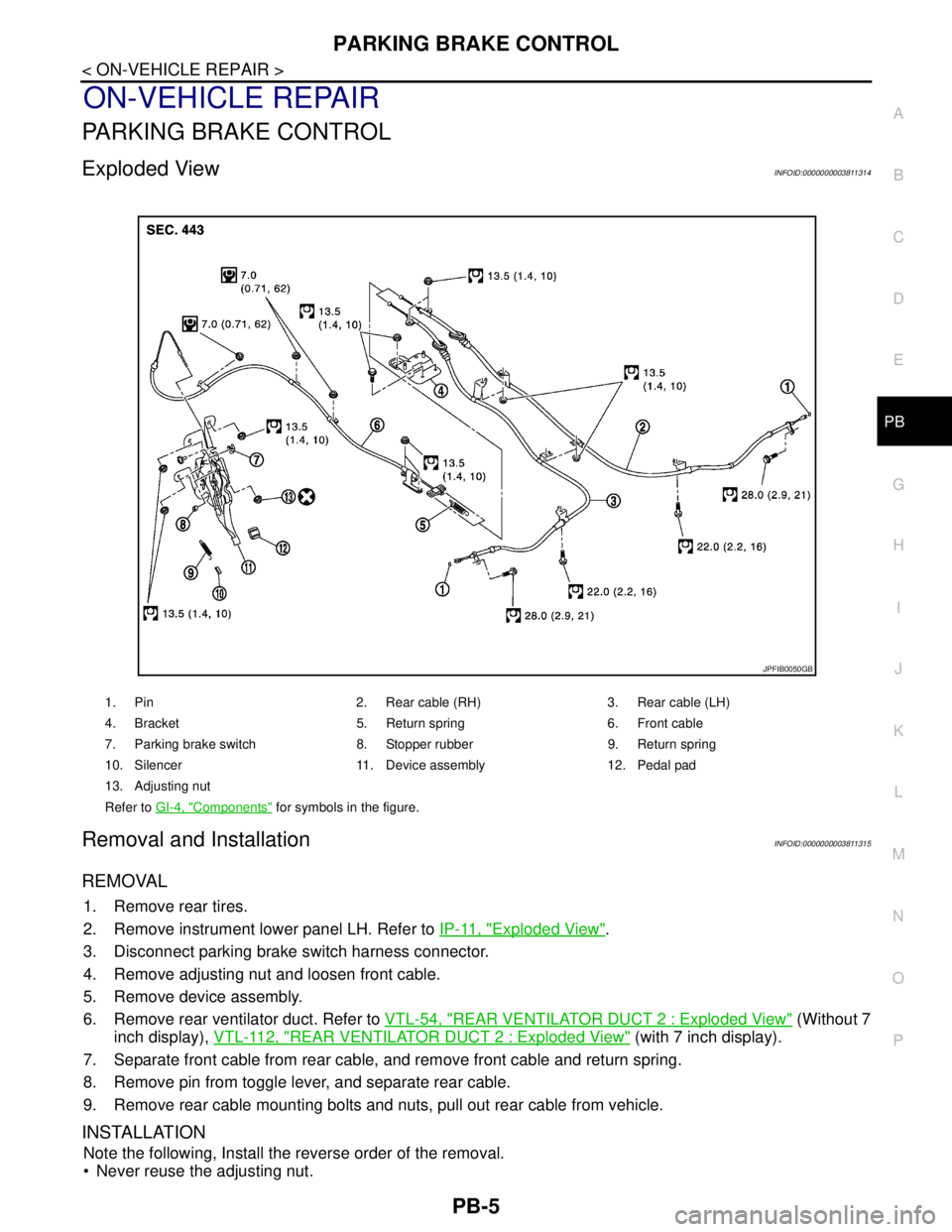
PARKING BRAKE CONTROL
PB-5
< ON-VEHICLE REPAIR >
C
D
E
G
H
I
J
K
L
MA
B
PB
N
O
P
ON-VEHICLE REPAIR
PARKING BRAKE CONTROL
Exploded ViewINFOID:0000000003811314
Removal and InstallationINFOID:0000000003811315
REMOVAL
1. Remove rear tires.
2. Remove instrument lower panel LH. Refer to IP-11, "
Exploded View".
3. Disconnect parking brake switch harness connector.
4. Remove adjusting nut and loosen front cable.
5. Remove device assembly.
6. Remove rear ventilator duct. Refer to VTL-54, "
REAR VENTILATOR DUCT 2 : Exploded View" (Without 7
inch display), VTL-112, "
REAR VENTILATOR DUCT 2 : Exploded View" (with 7 inch display).
7. Separate front cable from rear cable, and remove front cable and return spring.
8. Remove pin from toggle lever, and separate rear cable.
9. Remove rear cable mounting bolts and nuts, pull out rear cable from vehicle.
INSTALLATION
Note the following, Install the reverse order of the removal.
Never reuse the adjusting nut.
1. Pin 2. Rear cable (RH) 3. Rear cable (LH)
4. Bracket 5. Return spring 6. Front cable
7. Parking brake switch 8. Stopper rubber 9. Return spring
10. Silencer 11. Device assembly 12. Pedal pad
13. Adjusting nut
Refer to GI-4, "
Components" for symbols in the figure.
JPFIB0050GB
Page 3387 of 5121

PB-6
< ON-VEHICLE REPAIR >
PARKING BRAKE CONTROL
Adjustment
INFOID:0000000003811316
ADJUSTMENT AFTER INSTALLATION
Adjust the parking brake pedal stroke. Refer to PB-2, "Inspection and Adjustment".
Page 3388 of 5121
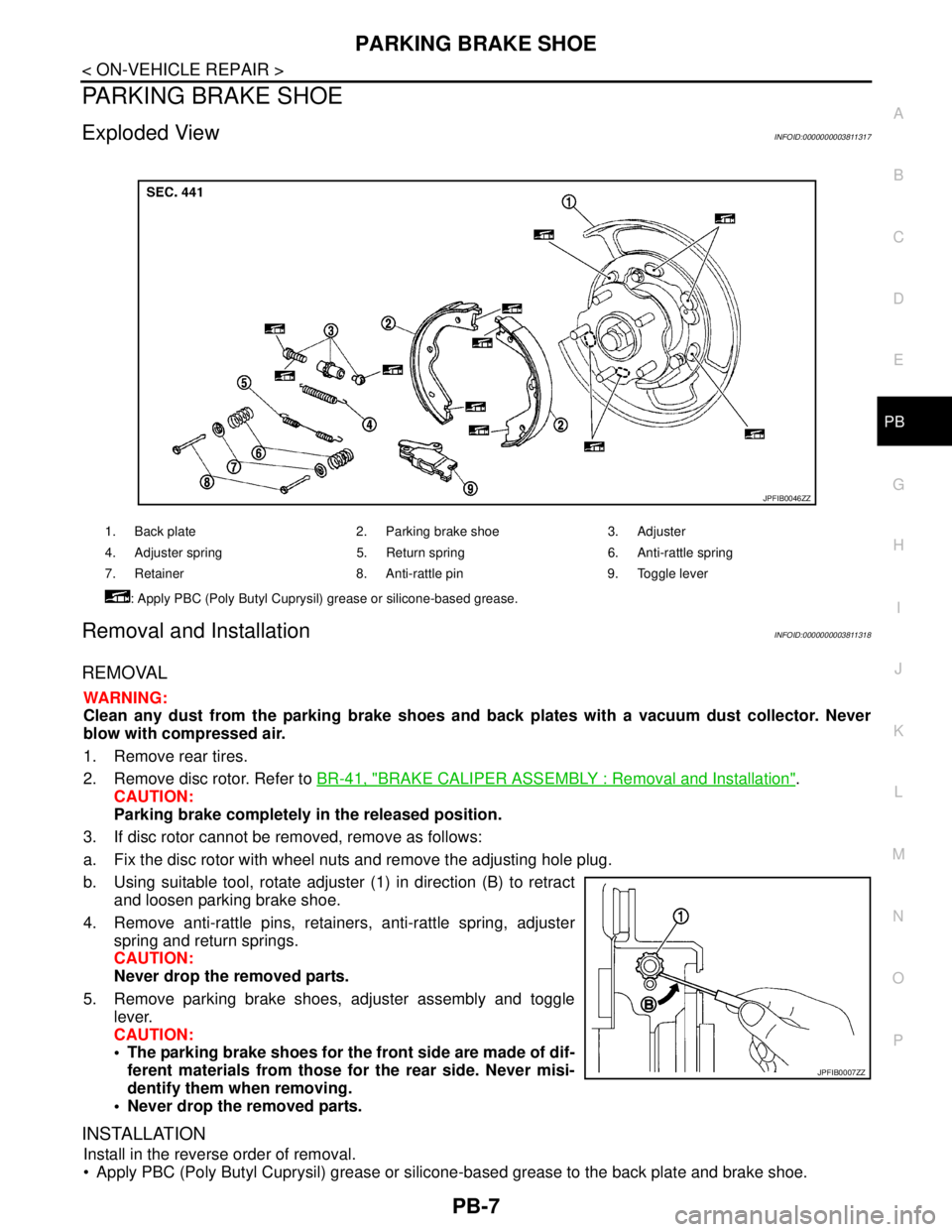
PARKING BRAKE SHOE
PB-7
< ON-VEHICLE REPAIR >
C
D
E
G
H
I
J
K
L
MA
B
PB
N
O
P
PARKING BRAKE SHOE
Exploded ViewINFOID:0000000003811317
Removal and InstallationINFOID:0000000003811318
REMOVAL
WARNING:
Clean any dust from the parking brake shoes and back plates with a vacuum dust collector. Never
blow with compressed air.
1. Remove rear tires.
2. Remove disc rotor. Refer to BR-41, "
BRAKE CALIPER ASSEMBLY : Removal and Installation".
CAUTION:
Parking brake completely in the released position.
3. If disc rotor cannot be removed, remove as follows:
a. Fix the disc rotor with wheel nuts and remove the adjusting hole plug.
b. Using suitable tool, rotate adjuster (1) in direction (B) to retract
and loosen parking brake shoe.
4. Remove anti-rattle pins, retainers, anti-rattle spring, adjuster
spring and return springs.
CAUTION:
Never drop the removed parts.
5. Remove parking brake shoes, adjuster assembly and toggle
lever.
CAUTION:
• The parking brake shoes for the front side are made of dif-
ferent materials from those for the rear side. Never misi-
dentify them when removing.
Never drop the removed parts.
INSTALLATION
Install in the reverse order of removal.
Apply PBC (Poly Butyl Cuprysil) grease or silicone-based grease to the back plate and brake shoe.
1. Back plate 2. Parking brake shoe 3. Adjuster
4. Adjuster spring 5. Return spring 6. Anti-rattle spring
7. Retainer 8. Anti-rattle pin 9. Toggle lever
: Apply PBC (Poly Butyl Cuprysil) grease or silicone-based grease.
JPFIB0046ZZ
JPFIB0007ZZ
Page 3389 of 5121
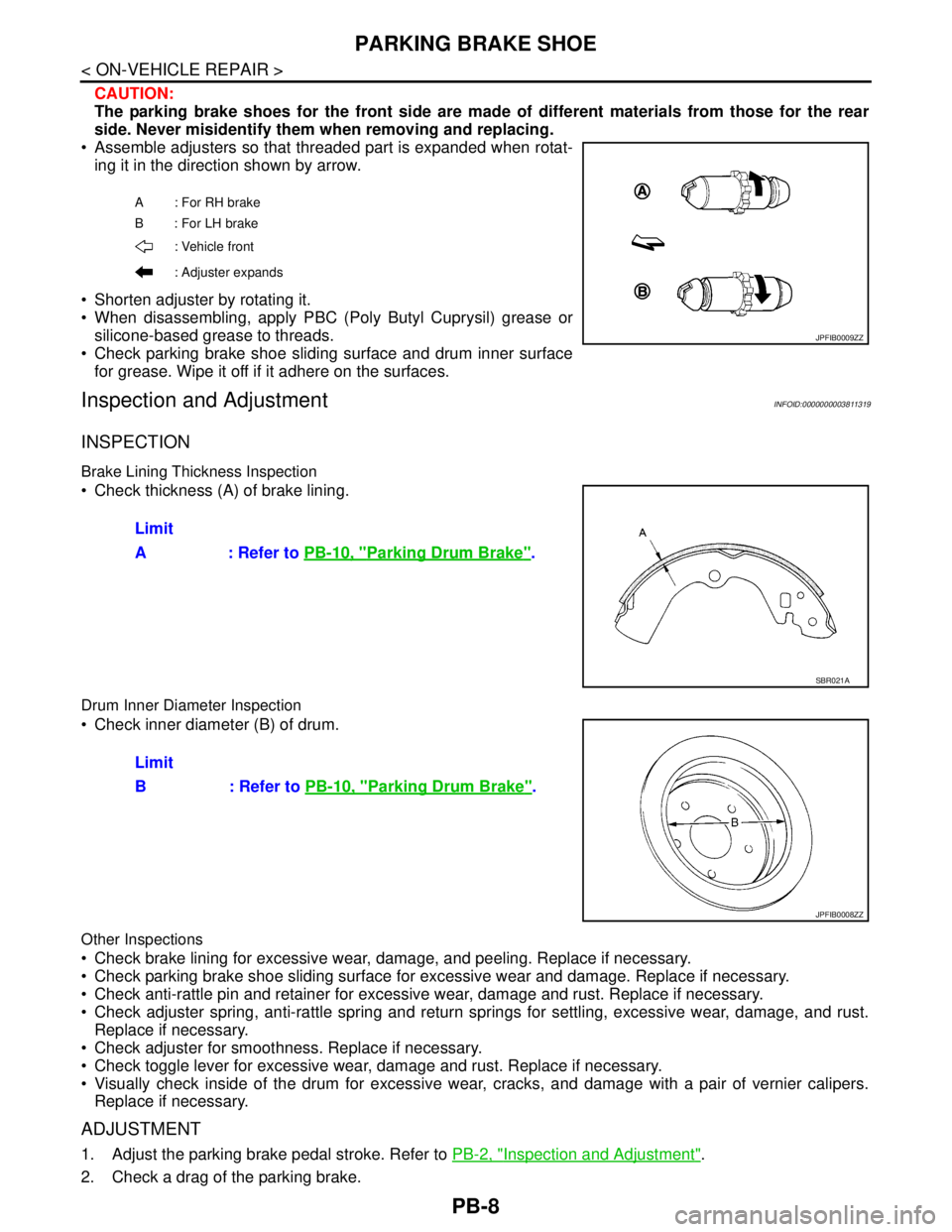
PB-8
< ON-VEHICLE REPAIR >
PARKING BRAKE SHOE
CAUTION:
The parking brake shoes for the front side are made of different materials from those for the rear
side. Never misidentify them when removing and replacing.
Assemble adjusters so that threaded part is expanded when rotat-
ing it in the direction shown by arrow.
Shorten adjuster by rotating it.
When disassembling, apply PBC (Poly Butyl Cuprysil) grease or
silicone-based grease to threads.
Check parking brake shoe sliding surface and drum inner surface
for grease. Wipe it off if it adhere on the surfaces.
Inspection and AdjustmentINFOID:0000000003811319
INSPECTION
Brake Lining Thickness Inspection
Check thickness (A) of brake lining.
Drum Inner Diameter Inspection
Check inner diameter (B) of drum.
Other Inspections
Check brake lining for excessive wear, damage, and peeling. Replace if necessary.
Check parking brake shoe sliding surface for excessive wear and damage. Replace if necessary.
Check anti-rattle pin and retainer for excessive wear, damage and rust. Replace if necessary.
Check adjuster spring, anti-rattle spring and return springs for settling, excessive wear, damage, and rust.
Replace if necessary.
Check adjuster for smoothness. Replace if necessary.
Check toggle lever for excessive wear, damage and rust. Replace if necessary.
Visually check inside of the drum for excessive wear, cracks, and damage with a pair of vernier calipers.
Replace if necessary.
ADJUSTMENT
1. Adjust the parking brake pedal stroke. Refer to PB-2, "Inspection and Adjustment".
2. Check a drag of the parking brake.
A : For RH brake
B : For LH brake
: Vehicle front
: Adjuster expands
JPFIB0009ZZ
Limit
A : Refer to PB-10, "
Parking Drum Brake".
SBR021A
Limit
B : Refer to PB-10, "
Parking Drum Brake".
JPFIB0008ZZ
Page 3390 of 5121

PARKING BRAKE SHOE
PB-9
< ON-VEHICLE REPAIR >
C
D
E
G
H
I
J
K
L
MA
B
PB
N
O
P
CAUTION:
If any drag is found, inspection the rear disc brake. Refer to BR-42, "
BRAKE CALIPER ASSEMBLY
: Disassembly and Assembly".